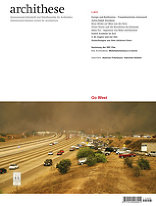Zeitschrift
archithese 5.2011
Go West
Adolf Loos’ stay in the USA between 1893 and 1896, as reflected in euphoric reports on the potential of the „land of unlimited opportunity“, firmly anchored a fascination with the USA in the minds of European architects like Richard Neutra, who first set off for New York and Chicago in 1923, worked with Frank Lloyd Wright, met fellow Austrian Rudolph Schindler in Los Angeles and ultimately opened his own architectural office in that city – an office that would shape the architecture of the West Coast between 1930 and 1970 like almost no other.
However, the architectural fascination with America dates back further: it began with Henry Hobson Richardson, whose monumentalised Neo-Romanesque can be described as the country’s first independent style and who was also duly paid tribute to by Sigfried Giedion in Space, Time and Architecture. The pre-eminent figure in the transcontinental cultural transfer was Frank Lloyd Wright, whose Wasmuth Portfolio appeared in Germany in 1910 and who not only cast a spell over Europe’s architects before the First World War, but in later decades as well. Werner Max Moser and Ernst Anderegg are examples of Swiss architects who spent years working in this American master’s office. However, America’s allure also went beyond Taliesin: the engineer Othmar Ammann had already emigrated to the New World in 1904 and architect William Lescaze did so in 1920. The fascism of the thirties ultimately drove a large number of Central European architects into exile. In a series of case studies, this issue, rather than focussing on the most prominent figures, is devoted to architects who have remained relatively unknown here in Switzerland, some of whom are yet to really be discovered.
Even after the Second World War, the transatlantic cultural transfer continued, as can be seen in the example of Oswald Mathias Ungers. The times of forced emigration are over, so in this age of globalisation it probably makes more sense to speak of migration.
The editors
04 Editorial
Architektur Aktuell
12 Zur Sanierung der ehemaligen HfG Ulm | Claudia Hildner
20 Ken Architekten. Mehrfamilienhaus Lindenrinde, Zürich | Verena Doerfler
Go West
28 Go West. Transatlantischer Austausch zwischen Europa und Kalifornien | Lilian Pfaff
34 «A more gemütlich version of the International Style» | Julius Ralph Davidson, Lilian Pfaff
40 Unscheinbares im Fokus. Beobachtungen zu Mies | Carsten Krohn
48 Der Konsum revolutioniert die Stadt. Die Planungen von Victor Gruen | Lilian Pfaff
54 Der Ingenieur von Kahn und Saarinen. Ein Gespräch mit Abba Tor | Kornel Ringli
60 Mensch – Form – Architektur. Der Psychologe und Kulturtheoretiker Rudolf Arnheim im Exil | Miriam Seifert-Waibel und Jörg Seifert
64 Die Suche vor der Festlegung. Oswald Mathias Ungers und die USA 1967 – 1977 | André Bideau
72 Die andere Möglichkeit. Anmerkungen aus dem nächsten Osten | Hannes Stiefel
Rubriken
78 Baugeschichten: Hotel Atlantis oder das Haus des Homo sacer | Stephan Trüby
82 Das Potenzial der Gegensätze: Interview mit Andreas Fuhrimann
und Gabrielle Hächler | Jørg Himmelreich
88 Junge Architektinnen und Architekten: Durisch Nolli | J. Christoph Bürkle
Aktuelles
90 IBA Basel 2020 | Martin Jann
93 Leserbrief
94 fsai
96 Neues aus der Industrie
102 Lieferbare Hefte
104 Vorschau und Impressum
However, the architectural fascination with America dates back further: it began with Henry Hobson Richardson, whose monumentalised Neo-Romanesque can be described as the country’s first independent style and who was also duly paid tribute to by Sigfried Giedion in Space, Time and Architecture. The pre-eminent figure in the transcontinental cultural transfer was Frank Lloyd Wright, whose Wasmuth Portfolio appeared in Germany in 1910 and who not only cast a spell over Europe’s architects before the First World War, but in later decades as well. Werner Max Moser and Ernst Anderegg are examples of Swiss architects who spent years working in this American master’s office. However, America’s allure also went beyond Taliesin: the engineer Othmar Ammann had already emigrated to the New World in 1904 and architect William Lescaze did so in 1920. The fascism of the thirties ultimately drove a large number of Central European architects into exile. In a series of case studies, this issue, rather than focussing on the most prominent figures, is devoted to architects who have remained relatively unknown here in Switzerland, some of whom are yet to really be discovered.
Even after the Second World War, the transatlantic cultural transfer continued, as can be seen in the example of Oswald Mathias Ungers. The times of forced emigration are over, so in this age of globalisation it probably makes more sense to speak of migration.
The editors
04 Editorial
Architektur Aktuell
12 Zur Sanierung der ehemaligen HfG Ulm | Claudia Hildner
20 Ken Architekten. Mehrfamilienhaus Lindenrinde, Zürich | Verena Doerfler
Go West
28 Go West. Transatlantischer Austausch zwischen Europa und Kalifornien | Lilian Pfaff
34 «A more gemütlich version of the International Style» | Julius Ralph Davidson, Lilian Pfaff
40 Unscheinbares im Fokus. Beobachtungen zu Mies | Carsten Krohn
48 Der Konsum revolutioniert die Stadt. Die Planungen von Victor Gruen | Lilian Pfaff
54 Der Ingenieur von Kahn und Saarinen. Ein Gespräch mit Abba Tor | Kornel Ringli
60 Mensch – Form – Architektur. Der Psychologe und Kulturtheoretiker Rudolf Arnheim im Exil | Miriam Seifert-Waibel und Jörg Seifert
64 Die Suche vor der Festlegung. Oswald Mathias Ungers und die USA 1967 – 1977 | André Bideau
72 Die andere Möglichkeit. Anmerkungen aus dem nächsten Osten | Hannes Stiefel
Rubriken
78 Baugeschichten: Hotel Atlantis oder das Haus des Homo sacer | Stephan Trüby
82 Das Potenzial der Gegensätze: Interview mit Andreas Fuhrimann
und Gabrielle Hächler | Jørg Himmelreich
88 Junge Architektinnen und Architekten: Durisch Nolli | J. Christoph Bürkle
Aktuelles
90 IBA Basel 2020 | Martin Jann
93 Leserbrief
94 fsai
96 Neues aus der Industrie
102 Lieferbare Hefte
104 Vorschau und Impressum
Weiterführende Links:
niggli Imprint der Braun Publishing AG







